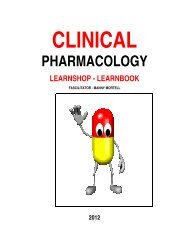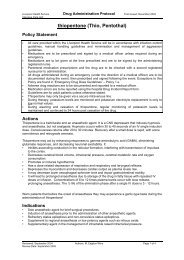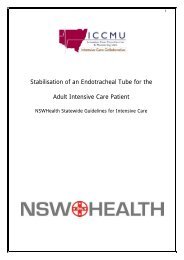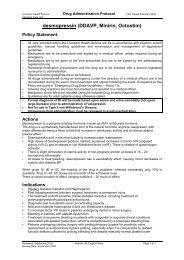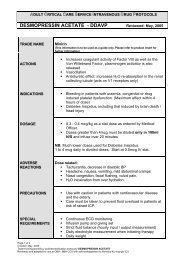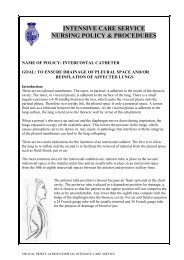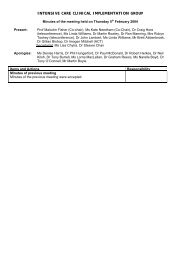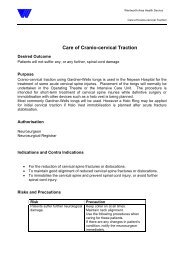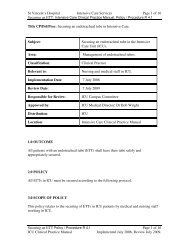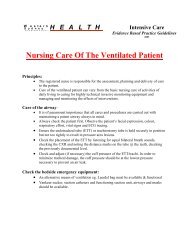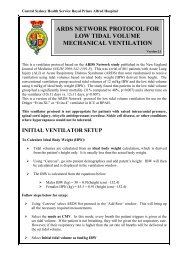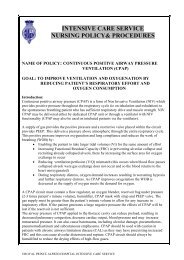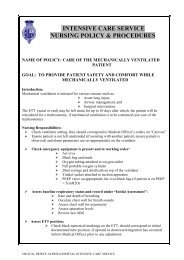A quick reference guide to haemofiltration and renal failure March ...
A quick reference guide to haemofiltration and renal failure March ...
A quick reference guide to haemofiltration and renal failure March ...
Create successful ePaper yourself
Turn your PDF publications into a flip-book with our unique Google optimized e-Paper software.
A <strong>quick</strong> <strong>reference</strong> <strong>guide</strong> <strong>to</strong><br />
<strong>haemofiltration</strong> <strong>and</strong> <strong>renal</strong> <strong>failure</strong><br />
<strong>March</strong> 2004<br />
Alison Bradshaw<br />
1
Page 3… Acute Renal Failure<br />
Page 4… Normal Kidney Function<br />
Page 5… Nephron Function<br />
Page 6… Definitions of Key Words<br />
Page 7… Indications for CRRT<br />
Page 8… TYPES OF CRRT<br />
SCUF<br />
Page 9… CVVHF<br />
Page 10… Predilution or Postdilution?<br />
Page 11… CVVHD<br />
Page 12… CVVHDF<br />
Page 13… Transport of molecules<br />
Page 14… PRINCIPLES OF DIALYSIS<br />
Diffusion<br />
Page15… Filtration<br />
Page 17... Convection<br />
Page 18… Application of Principles<br />
Page 19… Manipulation of Principles<br />
Summary of Principles<br />
Page 21… VASCULAR ACCESS<br />
Page 22… Dos <strong>and</strong> Don’ts of Vascular Access<br />
Page 23… ANTICOAGULATION<br />
Page 24… The Clotting Cascade<br />
Page 25… Heparin<br />
Page 26… Regional Heparinization <strong>and</strong> Citrate<br />
Page 27… Saline Flushes <strong>and</strong> Table of Anticoagulant Options<br />
Page 28… THE HAEMOFILTER<br />
Page 30… DIALYSATE COMPOSITION<br />
Page 32… CARE OF THE PATIENT<br />
Page 36… NUTRITION<br />
Page 37… CARE OF THE MACHINE<br />
Page 38… The BM 25<br />
Page 39… The Aquarius<br />
Page 40… Guide <strong>to</strong> Troubleshooting Alarms – The Aquarius<br />
Page 41… References<br />
2
Acute <strong>renal</strong> <strong>failure</strong> (ARF) is a common complication of the<br />
critically ill patient. Types of ARF include;<br />
PRERENAL FAILURE<br />
INTRARENAL FAILURE<br />
POSTRENAL FAILURE<br />
Pre<strong>renal</strong> <strong>failure</strong>; this is the most common type of ARF. It is a<br />
result of <strong>renal</strong> ischaemia caused by a significant decline in <strong>renal</strong><br />
blood flow. Decline in <strong>renal</strong> blood flow <strong>and</strong> a fall in glomerular<br />
filtration rate may result from hypovolaemia, a decrease in<br />
cardiac output or sepsis. (Dirkes,2000:581)<br />
Intra<strong>renal</strong> Failure; indicates injury <strong>to</strong> the nephrons within the<br />
kidney itself, usually caused by nephro<strong>to</strong>xins. Some of these<br />
potential nephro<strong>to</strong>xins are aminoglycosides, heavy metals,<br />
contrast dye. Prolonged ischaemia in the kidney will cause<br />
intra<strong>renal</strong> <strong>failure</strong> as well. (Dirkes, 2000:581)<br />
Post<strong>renal</strong> Failure; occurs when here is an obstruction <strong>to</strong> the<br />
outflow of urine from the kidney. Urinary tract obstruction,<br />
including <strong>renal</strong> s<strong>to</strong>nes, tumors <strong>and</strong> prostatic hypertrophy are<br />
common causal fac<strong>to</strong>rs. (Dirkes, 2000:581)<br />
3
The kidneys, with their approximate one million nephrons, are<br />
responsible for the filtration of blood <strong>and</strong> the subsequent<br />
formation of urine. In addition, they contribute <strong>to</strong> homeostasis<br />
by;<br />
• Regulating blood ionic composition<br />
(sodium, potassium, calcium, chloride <strong>and</strong> phosphate ions)<br />
• Maintaining blood osmolarity<br />
(through regulation of water <strong>and</strong> solute loss in urine)<br />
• Regulating blood volume<br />
(conservation or elimination of water)<br />
• Regulating blood pressure<br />
(activation of the renin-angiotensin system <strong>and</strong> <strong>renal</strong><br />
vasoconstriction)<br />
• Regulation of blood pH<br />
(retention of bicarbonate ions {HCO3-} or excretion of<br />
hydrogen ions {H+}<br />
(Tor<strong>to</strong>ra <strong>and</strong> Grabowski, 2000:914-915)<br />
4
Glomerular Filtration; blood flows through the afferent arteriole<br />
in<strong>to</strong> the glomerular capsule. It is here that water <strong>and</strong> most<br />
solutes in plasma pass from blood across the wall of the<br />
glomerular capillaries in<strong>to</strong> the glomerular capsule. Blood leaves<br />
the capsule via the efferent arteriole.<br />
Tubular Reabsorption; this system returns most of the filtered<br />
water <strong>and</strong> many of the filtered solutes back <strong>to</strong> the blood. In fact<br />
about 99% of the approximate 180 liters of filtrate is returned<br />
<strong>to</strong> the blood stream. Solutes that are reabsorbed, both actively<br />
<strong>and</strong> passively include glucose, amino acids, urea <strong>and</strong> ions such as<br />
Na+, K+, Ca2+, Cl+, HCO3- <strong>and</strong> phosphate.<br />
Tubular Secretion; as fluid moves along the tubule <strong>and</strong> through<br />
the collecting duct, waste products, (such as excess ions <strong>and</strong><br />
drugs) are added in<strong>to</strong> the fluid.<br />
Tor<strong>to</strong>ra <strong>and</strong> Grabowski, 2000:924)<br />
(Tor<strong>to</strong>ra <strong>and</strong> Grabowski, 2000:914-915)<br />
5
SOLUTE; a substance dissolved in a fluid or solvent <strong>to</strong> form a<br />
solution. A solution consists of a solute <strong>and</strong> a solvent.<br />
(Dorl<strong>and</strong> 2003:1719)<br />
SOLVENT; a substance, usually a liquid, which dissolves, or is<br />
capable of dissolving. (Dorl<strong>and</strong> 2003:1721)<br />
SEMIPERMEABLE MEMBRANE; a membrane permitting the<br />
passage of water <strong>and</strong> some small molecules <strong>and</strong> hindering the<br />
passage of larger molecules (Cole, L. Intensive Care Specialist Nepean Hospital 4<br />
June 2004 pers com)<br />
DIALYSATE; During haemodialysis, dialysate is the fluid that<br />
passes through the filter countercurrent <strong>to</strong> blood flow, which<br />
then accumulates the solutes <strong>and</strong> water being removed <strong>and</strong> is<br />
ultimately discarded (Cole, L. June 4 2004 pers com)<br />
REPLACEMENT FLUID; fluid administered <strong>to</strong> the blood side of<br />
the filter during haemfiltration. This may be done before the<br />
blood enters the filter (pre-filter) or after the blood leaves the<br />
filter (post-filter) (Bellomo, Ronco <strong>and</strong> Mehta 1996:S6)<br />
ULTRAFILTRATE; The net amount of water <strong>and</strong> solutes that are<br />
removed from the patient trough the filter. Ultrafiltrate can be<br />
removed during haemodialysis or <strong>haemofiltration</strong><br />
(Cole, L. June 4 2004 pers com)<br />
6
CRRT, or continuous <strong>renal</strong> replacement therapy, is any<br />
extracorporeal blood purification therapy intended <strong>to</strong> substitute<br />
for impaired <strong>renal</strong> function for an extended period of time, <strong>and</strong><br />
intended <strong>to</strong> run over 24 hours a day. (Bellomo, Ronco <strong>and</strong> Mehta, 1996:S3)<br />
CRRT is indicated for several reasons in the intensive care unit<br />
(ICU). Some of these indications are;<br />
Renal Failure, Diuretic-resistant pulmonary oedema,<br />
De<strong>to</strong>xification, Severe hepatic <strong>failure</strong> <strong>and</strong> Sepsis.<br />
Criteria for the initiation of dialytic therapy will depend upon the<br />
treating physician, but general criteria include oliguria, anuria,<br />
plasma urea concentration >35mmol/l, serum creatinine<br />
concentration >600umol/l, hyperkalaemia >6.5mmol/l, pulmonary<br />
oedema non-responsive <strong>to</strong> diuretics, metabolic acidosis (pH
SCUF<br />
Slow Continuous Ultrafiltration.<br />
SCUF is not associated with fluid replacement <strong>and</strong> is therefore<br />
the simplest form of CRRT. The primary aim of SCUF is <strong>to</strong><br />
achieve safe <strong>and</strong> effective management of fluid overload.<br />
SCUF can be either veno-venous (VV) or arterio-venous (AV).<br />
• In V-VSCUF the blood is pumped through a filter by a pump.<br />
• In A-VSCUF the blood is pumped through a filter by the<br />
patients own blood pressure.<br />
(Bellomo, Ronco <strong>and</strong> Mehta, 1996:S3)<br />
A-V SCUF V-V SCUF<br />
A V V + pump V<br />
UF UF<br />
(Bellomo, Ronco <strong>and</strong> Mehta, 1996:S4)<br />
A – artery, V – vein, UF – ultra filtrate.<br />
8
CVVHF<br />
Continuous Veno-Venous Haemofiltration<br />
Arterial cannulation carries added risks of bleeding, infection <strong>and</strong><br />
vessel damage. For this reason, the development of pumps <strong>to</strong><br />
achieve continuous <strong>haemofiltration</strong> using venous access only,<br />
prevails in most ICUs. A double lumen catheter is used <strong>to</strong> access<br />
a central vein, usually femoral, subclavian or jugular.<br />
Blood is driven though a highly permeable membrane<br />
(haemofilter) by the peristaltic pump. This is achieved through an<br />
extracorporeal circuit, whereby blood is removed through one<br />
lumen (called the arterial) <strong>and</strong> then returned <strong>to</strong> circulation via<br />
the other lumen (called the venous lumen). Ultrafiltrate<br />
generated as a result of movement across the membrane is<br />
replaced with appropriate fluid <strong>to</strong> achieve volume control <strong>and</strong><br />
blood purification. The addition of replacement fluid may be pre-<br />
filter (predilution) or post-filter (postdilution). (Bellomo, Ronco <strong>and</strong><br />
Mehta, 1996:S3) <strong>and</strong> (Bellomo in Eo, 1998:367).<br />
V + pump V<br />
UF<br />
V – vein, R – replacement fluid, UF – ultrafiltrate.<br />
R<br />
9
Predilution or Postdilution???<br />
The concept of replacing fluids, whether before or after the<br />
haemofilter achieve the same goals - replacing lost volume <strong>and</strong><br />
replacement of electrolytes. However, predilution provides the<br />
added benefit of a continuous flush for the haemofilter, <strong>and</strong> in<br />
effect dilutes the blood flowing through it (Dirkes 2000:585)<br />
This method may reduce the incidence of clotting in the<br />
haemofilter but will reduce solute clearance due <strong>to</strong><br />
haemodiltution (Cole, L. June 4 2004).<br />
Predilution Postdilution<br />
R R<br />
V + pump V V + pump V<br />
UF UF<br />
V – vein, R- replacement fluid, UF – ultra filtrate.<br />
10
CVVHD<br />
Continuous Veno-Venous Haemodialysis<br />
This technique involves a slow countercurrent dialysate flow being<br />
added <strong>to</strong> the haemofilter (through the ultrafiltrate – dialysate<br />
compartment of the membrane) Solute clearance is mainly<br />
diffusive. Fluid replacement is not routinely added <strong>to</strong> the circuit.<br />
(Bellomo, Ronco <strong>and</strong> Mehta, 1996:S5)<br />
V + pump V<br />
Dialysate out Dialysate in<br />
+ UF<br />
(Bellomo, Ronco <strong>and</strong> Mehta, 1996:S5)<br />
V – vein, UF – ultra filtrate<br />
11
CVVHDF<br />
Continuous Veno-Venous Haemodiafiltration<br />
In this type of CRRT, a slow countercurrent dialysate flow is<br />
added <strong>to</strong> the haemofilter. Solute removal is both diffusive <strong>and</strong><br />
convective, <strong>and</strong> is thought <strong>to</strong> be the most effective method of<br />
removal of wastes in CRRT. (Bellomo, Ronco <strong>and</strong> Mehta, 1996:S4)<br />
Fluid replacement is routinely added, as clinically indicated, <strong>to</strong><br />
maintain desired fluid balance. This is due <strong>to</strong> the ultrafiltration<br />
rate being greater than the desired patient fluid loss.<br />
(Bellomo, Ronco <strong>and</strong> Mehta, 1996:S4)<br />
V + pump V<br />
Dialysate out Dialysate In<br />
+ UF<br />
V – vein, R – replacement fluid, UF – ultrafiltrate<br />
R<br />
12
Molecules are measured in dal<strong>to</strong>ns (Da), which represents their<br />
‘size’. The size of the molecule will determine whether that<br />
molecule will be moved through the haemofilter membrane.<br />
Diffusion or convection are the mechanisms for transport of the<br />
molecules.<br />
Molecule Molecular Weight<br />
Sodium 33<br />
Calcium 40<br />
Urea 60<br />
Creatinine 113<br />
Uric acid 168<br />
Dextrose 180<br />
Vitamin B12 1352<br />
Myoglobin 17 000<br />
Albumin 68 000<br />
Globulin 150 000<br />
Red blood cells, white blood cells, bacteria <strong>and</strong> virus’ are larger.<br />
13
DIFFUSION<br />
Diffusion is defined as the movement of solutes from an area of<br />
high solute concentration <strong>to</strong> an area of low solute concentration<br />
across a semipermeable membrane. Ultimately, concentration of<br />
the solute will be equal on both sides of the membrane. Diffusion<br />
is directly proportional <strong>to</strong> the concentration gradient,<br />
temperature <strong>and</strong> surface area. Diffusion is inversely proportional<br />
<strong>to</strong> the thickness of the membrane. (Bellomo, Ronco <strong>and</strong> Mehta, 1996:S6)<br />
Low concentration<br />
high concentration equal<br />
concentration<br />
The concentration gradient is maintained in filtration because we<br />
are continually adding fresh dialysate fluid <strong>to</strong> the dialysate side.<br />
14
FILTRATION<br />
Filtration is defined as the movement of water through a<br />
permeable membrane caused by a pressure gradient. High<br />
molecular weight substances are separated by the membrane<br />
according <strong>to</strong> their size. (Dorl<strong>and</strong> 2003:702)<br />
In <strong>renal</strong> replacement therapy, it is the process by which plasma<br />
water <strong>and</strong> filterable solutes are separated from whole blood<br />
across a semipermeable membrane as a result of transmembrane<br />
pressure. (Bellomo, Ronco <strong>and</strong> Mehta, 1996:S6)<br />
Positive pressure forces solutes through the membrane.<br />
Compare this with your garden hose…think of the tap as the blood pump, <strong>and</strong><br />
the nozzle as the resistance offered by the return of blood <strong>to</strong> the patient.<br />
The hose now becomes the membrane, if holes are punched along the surface<br />
of the hose pipe. The more you turn the ‘tap’ on (the blood pump), <strong>and</strong> /or<br />
the more you constrict the nozzle (pts vascular access), the greater the<br />
pressure inside the hose. The higher the pressure, the further the water<br />
will squirt out of the holes, <strong>and</strong> the more water you will lose across the<br />
membrane.<br />
Annaal looggyy<br />
15
FILTRATION CONTINUED………<br />
The change in pressure gradient can be either positive as<br />
described previously, or it can be a negative pressure.<br />
A vacuum pump, gravity or osmotic pressure gradients can create<br />
negative pressure on the dialysate side of the filter.<br />
Filtration can be achieved through either increasing the pressure<br />
on the blood side of the filter or increasing the negative pressure<br />
on the dialysate side of the filter. (Whitaker in Clochsey et al 1996:936)<br />
Volumetric pumps are used on the dialysate side of the filter <strong>to</strong><br />
precisely control the negative pressure <strong>and</strong> therefore the volume<br />
of ultrafiltrate produced. (Bellomo, Ronco <strong>and</strong> Mehta, 1996:s6)<br />
16
CONVECTION<br />
Convection is defined as a process of ‘solvent drag’. Solutes are<br />
washed across the semipermeable membrane <strong>to</strong>gether with the<br />
solvent. This is achieved by the solvent drag or filtration<br />
mechanism which occurs as a result of a transmembrane pressure<br />
gradient. (Bellomo, Ronco <strong>and</strong> Mehta, 1996:s6)<br />
The size of the pores in the membrane determines what solutes<br />
can be washed <strong>to</strong> the other side. Small solutes such as amino<br />
acids, glucose, vitamins, small plasma proteins, ammonia, urea <strong>and</strong><br />
electrolytes are able <strong>to</strong> move through the semipermeable<br />
membrane. This is in contrast <strong>to</strong> the larger molecules such as<br />
blood cells, most plasma proteins <strong>and</strong> platelets, which are <strong>to</strong>o<br />
large <strong>to</strong> cross the membrane. (Tor<strong>to</strong>ra <strong>and</strong> Grabowski 2000:961)<br />
17
lood from pt –<br />
at high pressure negative pressure –<br />
countercurrent flow<br />
wastes pumped out<br />
• Blood will run at between 50 <strong>to</strong> 200 mls per hour<br />
• Dialysate will run at between 15 – 30 mls per minute<br />
• Countercurrent is applied in CVVHD <strong>and</strong> CVVHDF<br />
• Wastes are removed from the blood by diffusion <strong>and</strong><br />
convection – water is removed by filtration. [Hawkins 2003]<br />
18
MANIPULATION OF THESE H PRINCIPLES<br />
Diffusion is increased by;<br />
• Increasing the rate of the dialysate flow<br />
• Increasing the rate of blood flow<br />
• Using countercurrent flow<br />
• Composition of dialysate fluid <strong>to</strong> increase the concentration<br />
gradient<br />
• Increasing the surface area of the membrane<br />
Diffusion is decreased by;<br />
• Decreasing the rate of the dialysis flow<br />
• Decreasing the rate of blood flow<br />
• Dilution of the blood before the filter (pre-dilution<br />
replacement fluid)<br />
• Decreasing the area of the membrane<br />
Ultrafiltration <strong>and</strong> Convection are increased by;<br />
• An increase in positive pressure on the blood side of the<br />
circuit. This can be caused by either an increase in blood<br />
flow or an increase in the flow of pre-dilution replacement<br />
fluid.<br />
• An increase in negative pressure on the ultrafiltrate side of<br />
the membrane.<br />
19
Ultrafiltration <strong>and</strong> Convection are decreased by;<br />
• A decrease in the positive pressure on the blood side of the<br />
circuit. This can be due <strong>to</strong> either a decrease in blood flow<br />
rate or a decrease in the rate of pre-dilution replacement<br />
fluid.<br />
• A decrease in negative pressure on the ultrafiltrate side<br />
caused by a decrease in the flow rate of the ultrafiltrate<br />
pump. [Hawkins, 2003]<br />
In summary, the following table gives a diagrammatic<br />
representation of the changes that occur with manipulation of<br />
the principles of CRRT.<br />
Rate of<br />
blood flow<br />
Rate of<br />
dialysate<br />
or UF flow<br />
Diffusion<br />
Increased<br />
Diffusion<br />
Decreased<br />
Convection &<br />
Ultrafiltrate<br />
Increased<br />
Convection &<br />
Ultrafiltrate<br />
Decreased<br />
20
• A double lumen catheter, also known as a ‘vascath’ is inserted<br />
aseptically in<strong>to</strong> either the internal jugular, subclavian or<br />
femoral vein. The care of the catheter is a very important<br />
aspect of CRRT. [Rodda, 2003]<br />
• With out good quality access, CRRT can prove problematic <strong>and</strong><br />
ineffective.<br />
• Patents in intensive care are susceptible <strong>to</strong> infections because<br />
of depression of the immune system. With this in mind, all<br />
manipulation of the catheter should be done aseptically.<br />
(Ronco <strong>and</strong> Bellomo 1996:s100)<br />
• Venovenous access allows for blood <strong>to</strong> be pumped out of the<br />
large vein, through the extracorporeal circuit <strong>and</strong> returned <strong>to</strong><br />
the same vein. Remembering that cardiac output is 4 – 8 liters<br />
a minute, it is not likely that recirculation is a problem.<br />
(College Study Guide, 2004:7-42 <strong>and</strong> Cole, L. June 4 2004, pers com)<br />
21
THE DO’S AND DON’T’S OF VASCULAR ACCESS<br />
DO confirm position by x ray, except if it is placed in the femoral<br />
vein. X ray will exclude or confirm complications of insertion such<br />
as pneumothorax.<br />
DON’T start therapy until position is confirmed.<br />
DO ensure connections are tight, the lines are secured <strong>and</strong> in<br />
view at all times.<br />
DON’T allow the area between the patient <strong>and</strong> the machine <strong>to</strong> be<br />
<strong>to</strong>o big, this deters people from ‘stepping over’ the lines.<br />
DO heparin lock both lumens when not in use, <strong>and</strong> mark on the line<br />
that it has been heparin locked.<br />
DON’T flush the heparin lock in<strong>to</strong> the patient; be sure <strong>to</strong><br />
withdraw the heparin lock prior <strong>to</strong> recommencing treatment.<br />
DO dressings regularly <strong>and</strong> aseptically. Use a clear occlusive<br />
dressing, the insertion site should be visible at all times.<br />
22
AIM – <strong>to</strong> prevent the filter <strong>and</strong> the circuit from clotting, without<br />
interfering with the patients’ systemic coagulation. With specific<br />
patient conditions, no anticoagulation may be adopted.<br />
To comprehensively underst<strong>and</strong> anticoagulation therapies, you<br />
must be familiar with the clotting cascade. While detailed<br />
explanation is beyond the scope of this manual, a summary of the<br />
main points will assist in underst<strong>and</strong>ing.<br />
THE CLOTTING CASCADE<br />
Clotting is a complex cascade of reactions involving clotting<br />
fac<strong>to</strong>rs which are activated by each other, in a fixed sequence.<br />
These fac<strong>to</strong>rs include;<br />
• calcium ions (Ca2+)<br />
• several inactive enzymes that are synthesized by the liver<br />
<strong>and</strong> released in<strong>to</strong> the bloodstream<br />
• various molecules - associated with platelets<br />
(Tor<strong>to</strong>ra <strong>and</strong> Grabowski 2000:623)<br />
- or released by damaged tissues<br />
23
In clotting,<br />
coagulation fac<strong>to</strong>rs<br />
activate other<br />
fac<strong>to</strong>rs in sequence,<br />
resulting in a<br />
cascade of reactions.<br />
Citrate binds with<br />
ionized calcium<br />
Heparin inhibits<br />
activation of<br />
fac<strong>to</strong>r X<br />
NOTE; how calcium<br />
plays a role in all<br />
three stages of the<br />
clotting cascade!<br />
(Tor<strong>to</strong>ra <strong>and</strong> Grabowski 2000:625)<br />
24
MOST COMMONLY USED ANTICOAGULANT THERAPIES<br />
* HEPARIN * CITRATE * REGIONAL HEPARINIZATION<br />
* SALINE FLUSHES * NO ANTICOAGULATION<br />
HEPARIN<br />
• Heparin acts by binding <strong>to</strong> <strong>and</strong> greatly enhancing the<br />
activity of antithrombin III, <strong>and</strong> from inhibition of a<br />
number of coagulation fac<strong>to</strong>rs – particularly activated<br />
fac<strong>to</strong>r X. (Dorl<strong>and</strong> 2003:836).<br />
• Heparin is the most commonly used anticoagulant.<br />
• The extracorporeal circuit is primed with heparinized saline.<br />
Depending upon the patients own coagulation, an infusion of<br />
heparin is delivered in<strong>to</strong> the circuit prior <strong>to</strong> the<br />
haemofilter.<br />
• Patient coagulation levels should be taken prior <strong>to</strong> the<br />
commencement of CRRT. At 2 hours post commencement<br />
draw blood from the blue (venous) port <strong>and</strong> check machine<br />
APTT. This needs <strong>to</strong> be repeated every 2hours until the<br />
machine APTT lies between 60 – 80 seconds. Once stable<br />
check 6 th hourly. Blood needs <strong>to</strong> be taken from both the<br />
patient <strong>and</strong> the machine for comparison. Once coagulation is<br />
stable within the set limits, bloods are attended 12 hourly.<br />
25
REGIONAL HEPARINIZATION<br />
• In regional heparinsation, heparin is infused prior <strong>to</strong> the<br />
haemofilter, <strong>and</strong> its antagonist, protamine, is infused post<br />
filter. This effectively reverses the action of any heparin<br />
passing through the filter.<br />
(Dirkes 2000:586).<br />
CITRATE<br />
• Regional anticoagulation with sodium citrate is an effective<br />
form of anticoagulation for CRRT for patients with<br />
contraindications <strong>to</strong> heparin. It is infused directly in<strong>to</strong> the<br />
circuit, pre filter (Macias 1996:S15).<br />
• Citrate prevents clotting by binding <strong>to</strong> ionized calcium in the<br />
blood. Note the clotting cascade.<br />
• Calcium gluconate is infused post filter <strong>to</strong> prevent systemic<br />
anticoagulation <strong>and</strong> <strong>to</strong> avoid hypocalcaemia (Bellomo in oh, 1997:368).<br />
• Use of citrate can be complicated with metabolic alkalalosis<br />
because the citrate returning <strong>to</strong> the patient is metabolised <strong>to</strong><br />
bicarbonate (Macias 1996:S15).<br />
• Citrate is contraindicated in patients with hepatic dysfunction.<br />
26
SALINE FLUSHES<br />
• In patients that are unable <strong>to</strong> <strong>to</strong>lerate anticoagulation,<br />
routine saline flushes <strong>to</strong> the circuit can be helpful in keeping<br />
the circuit free of clots (Dirkes 2000:586).<br />
• Saline is not an anticoagulant <strong>and</strong> flushing the circuit can<br />
only assist in preventing clots <strong>and</strong> does not guarantee<br />
longevity of the haemofilter (Dirkes 2000:586).<br />
TABLE OF ANICOAGULANT OPTIONS IN CRRT<br />
ANTICOAGULANT COMMENTS<br />
Heparin Easy, inexpensive. Potential for systemic<br />
bleeding or heparin induced<br />
thrombocy<strong>to</strong>penia<br />
Regional Heparinisation Heparin infused prefilter <strong>and</strong> protamine<br />
infused post filter.<br />
Citrate Labor intensive. Requires routine<br />
moni<strong>to</strong>ring of blood results <strong>to</strong> control<br />
ionised calcium <strong>and</strong> magnesium. System<br />
requires calcium infusion post filter.<br />
Contraindicated in hepatic dysfunction.<br />
Saline Flushes Not an anticoagulant. Helps flush<br />
haemofilter, possibly prolonging filter<br />
life.<br />
No Anticoagulation Success varies. Requires faster rate of<br />
blood flow.<br />
Compiled from (Dirkes 2000:586)<br />
27
The haemofilter, otherwise known as ‘the kidney’, is the ‘heart’ of<br />
the <strong>haemofiltration</strong> process. It is here that blood is filtered,<br />
with the removal of water <strong>and</strong> dissolved solutes.<br />
There are two types of filters, the parallel plate filter <strong>and</strong> the<br />
hollow fibre filter. The hollow fibre filter is used predominantly<br />
in this ICU, <strong>and</strong> so it will be the feature of this discussion.<br />
These haemofilters are mostly made from polymers, <strong>and</strong> are<br />
constructed of porous hollow fibers. The large pores allow for the<br />
passage of larger molecules along with increased volume of fluid<br />
(Dirkes 2000:583)<br />
The fibres are bundled <strong>to</strong>gether in a cylindrical tube, <strong>and</strong> are<br />
encapsulated so that they are free at either end of the tube.<br />
This allows blood <strong>to</strong> enter <strong>and</strong> exit the hollow lumens, but not <strong>to</strong><br />
circulate around the outside of the fibres.<br />
As mentioned previously, molecules are measured in Dal<strong>to</strong>ns.<br />
Commonly, the average filter pore size is 30, 000 Dal<strong>to</strong>ns. The<br />
table below represents common molecular weights. Only very<br />
small molecules pass freely through the filter.<br />
28
There is restriction of movement of the medium sized molecules,<br />
e.g. Vitamin B12, <strong>and</strong> very little movement across of large<br />
molecules, e.g. albumin.<br />
Molecule Molecular Weight (dal<strong>to</strong>ns)<br />
Sodium 33<br />
Calcium 40<br />
Urea 60<br />
Creatinine 113<br />
Uric acid 168<br />
Dextrose 180<br />
Vitamin B12 1352<br />
Myoglobin 17 000<br />
Albumin 68 000<br />
Globulin 150 000<br />
The fibres within the filter vary in size <strong>and</strong> composition, with<br />
some materials said <strong>to</strong> be more biocompatible than others <strong>and</strong><br />
other said <strong>to</strong> have septic media<strong>to</strong>r absorption properties.<br />
Another important fac<strong>to</strong>r with filters is their size. Filter size is<br />
described in square meters. The larger the surface area in square<br />
meters, the greater the area of blood contact with the fibres<br />
<strong>and</strong> thus the potential for improved ultrafiltrate formation.<br />
([Rodda 2003])<br />
29
The ability <strong>to</strong> modify replacement fluid (for CVVH) <strong>and</strong> dialysate<br />
(for CVVHD) in order <strong>to</strong> change plasma composition is one of the<br />
major advantages of CRRT. For instance, the concentration of<br />
ions such as potassium can be manipulated <strong>and</strong> the concentration<br />
of bicarbonate can be varied <strong>to</strong> correct a metabolic acidosis (Mehta<br />
2002:344).<br />
The composition of the replacement fluid or dialysate is most<br />
commonly a st<strong>and</strong>ard solution with predetermined concentrations<br />
of base (usually lactate) <strong>and</strong> ions, however, there may be<br />
occasions where cus<strong>to</strong>mising the solutions proves beneficial.<br />
(Mehta 2002:344).<br />
Since high serum potassium is common in acute <strong>renal</strong> <strong>failure</strong>, such<br />
commercially prepared solutions are low in this ion, <strong>and</strong> so it may<br />
be necessary <strong>to</strong> add this <strong>to</strong> the replacement fluid.<br />
Lactate is used as a buffer in prepared solutions, <strong>and</strong> is stable in<br />
this environment. Solutions containing lactate are suitable for use<br />
in most patients, but in the critically ill patient who may have<br />
difficulty clearing lactate, as with liver <strong>failure</strong>, a bicarbonate<br />
solution may be necessary.<br />
30
Bicarbonate is unstable in solution, <strong>and</strong> so should be added just<br />
prior <strong>to</strong> use (Baldwin, Elderkin <strong>and</strong> Bridge in Bellomo et al 2002:85)<br />
Hospal manufacture a solution with bicarbonate in a separate<br />
compartment, which is mixed with the larger compartment prior<br />
<strong>to</strong> treatment. After mixing of the two compartments,<br />
composition of the fluid is represented in the table below;<br />
Calcium Ca2 1.75 mmol/L<br />
Magnesium Mg2+ 0.5mmol/L<br />
Sodium Na+ 140mmol/L<br />
Chloride Cl- 109.5mmol/L<br />
Lactate 3mmol/L<br />
Bicarbonate HCO3 32mmol/L<br />
Composition of st<strong>and</strong>ard replacement or dialysate fluid;<br />
Blood Semipermeable Dialysate /<br />
Mmol/l membrane replacement fluid<br />
Sodium 134 -146 140<br />
Potassium 3.4 – 5.0 1<br />
Calcium 1.15 - 1.30 1.63<br />
Magnesium 0.7 – 1.1 0.75<br />
Chloride 98 – 108 100<br />
Lactate < 2.0 45<br />
Glucose 3.9 – 6.2 10<br />
Urea 3.0 – 8.0 0<br />
Creatinine 0.08 – 0.12 0<br />
31
The patient who requires CRRT is already ill, may or may not be<br />
mechanically ventilated <strong>and</strong> will have the stressors of<br />
hospitalisation well <strong>and</strong> truly evident. Electrolyte imbalances, as<br />
well as uremic states have the potential <strong>to</strong> cloud or even change<br />
the way people would normally behave. Reassurance <strong>and</strong><br />
explanation of the process of CRRT may help <strong>to</strong> bring calm <strong>to</strong><br />
your patient, <strong>and</strong> their family. Remember, the person in your care<br />
knows nothing of the process of CRRT.<br />
The first stage is the insertion of the catheter, (the care of<br />
vascular access has been covered previously). Remember, if<br />
vascular access is subclavian or jugular, your patient will have<br />
their head covered with the sterile drape during insertion of the<br />
line. Be there for comfort <strong>and</strong> reassurance.<br />
Once catheter position has been confirmed, with the circuit<br />
primed <strong>and</strong> filtration orders established it is important that the<br />
patient has an adequate blood pressure prior <strong>to</strong> connection.<br />
32
BASELINE OBSERVATIONS <strong>to</strong> establish interventional<br />
changes are imperative. This should include blood pressure, heart<br />
rate, temperature, respiration rate <strong>and</strong> CVP (if available).<br />
The flow rate has the potential <strong>to</strong> change blood pressure,<br />
since it is drawing volume from the patients’ intravascular space.<br />
To over come this, turn flow rates up according <strong>to</strong> <strong>to</strong>lerance,<br />
remembering that the faster the flow rate, the more efficient<br />
the solute clearance <strong>and</strong> the potential of clotting in the filter is<br />
reduced. Flow rates are usually set at 200mls per minute.<br />
Heart rate may increase due <strong>to</strong> the initial fall in blood pressure<br />
<strong>and</strong> the body interpreting this as hypovolaemia. This is in<br />
response <strong>to</strong> a decrease in cardiac output, moni<strong>to</strong>red by<br />
barorecep<strong>to</strong>rs in the arch of the aorta <strong>and</strong> the carotid sinus.<br />
(Tor<strong>to</strong>ra <strong>and</strong> Grabowski 2000:688)<br />
Temperature will fall, with the blood in the extracorporeal<br />
circuit being exposed <strong>to</strong> room temperatures. Warming devices are<br />
located on the machine <strong>to</strong> warm replacement fluid, <strong>and</strong> in some<br />
cases the temperature may be maneuvered <strong>to</strong> suit individuals. If<br />
patient temperature continues <strong>to</strong> fall, the use of blankets,<br />
warming blanket or aluminium foil around the circuit can be<br />
utilised (Smith, 1999:299)<br />
33
Respira<strong>to</strong>ry rate may or may not change, but will be influenced<br />
by acid – base balance. It is worthwhile <strong>to</strong> observe respira<strong>to</strong>ry<br />
function in conjunction with other haemodynamic parameters.<br />
Central venous pressure moni<strong>to</strong>ring is used as a <strong>guide</strong> <strong>to</strong> right<br />
ventricular filling. Dynamic changes in CVP corresponding with<br />
fluid loading or loss indicate the patients’ intravascular volume<br />
status. CVP changes with the use of positive end expira<strong>to</strong>ry<br />
pressure in mechanical ventilation. (Gomersall <strong>and</strong> Oh, in Oh 1997:832)<br />
Continuous cardiac moni<strong>to</strong>ring allows for alarm limits <strong>to</strong> be set on<br />
haemodynamic parameters, as well as continuous observation of<br />
heart rhythm <strong>and</strong> rate. ECG changes can be seen in the patient<br />
with electrolyte imbalances, peaked T waves may indicate<br />
hyperkalaemia. (Porterfield 2002:51)<br />
Blood tests for electrolytes, urea, creatinine, liver function,<br />
coagulation <strong>and</strong> full blood count are required not only <strong>to</strong> compare<br />
with bloods during <strong>and</strong> after CRRT, but also <strong>to</strong> formulate<br />
treatment regimes. The importance of coagulation studies has<br />
been discussed previously. Frequent blood sugar levels are<br />
necessary if dextrose is a component of the CRRT fluid<br />
(Cole, L. June 4 004, pers com)<br />
34
NORMAL<br />
BLOOD<br />
VALUES<br />
Na 135 – 145 mmol/L<br />
K+ 3.5 – 5.0 mmol/L<br />
HCO3 23 – 29 mmol/L<br />
Urea 2.5 – 7.0 mmol/L<br />
Creatinine 60 – 120 umol/L<br />
Haemorrhage is a very real possibility for the patient connected<br />
<strong>to</strong> CRRT. The importance of having all lines visible <strong>and</strong> well<br />
secured has been stressed previously. The addition of<br />
anticoagulation <strong>to</strong> the circuit adds <strong>to</strong> this possible problem, as<br />
does an underlying coagulopathy in the patient.<br />
Air Embolus can pose a life threatening situation. Ensuring that<br />
all connections are luer locked, <strong>and</strong> lines secured <strong>to</strong> the patient<br />
will help protect against such an event. However, if an air embolus<br />
occurs, your patient will be observed <strong>to</strong> have difficulty breathing,<br />
have pain in the mid chest <strong>and</strong> shoulder, be pale, nauseated <strong>and</strong><br />
light headed (Hadaway 2002:104).<br />
Prompt action is required. Place the patient on their left side <strong>and</strong><br />
in the Trendelenburg position. Administer 100% oxygen <strong>and</strong> notify<br />
the medical staff immediately. This action moves the air embolus<br />
away from the pulmonary valve, <strong>and</strong> the oxygen causes the<br />
nitrogen in the air bubble <strong>to</strong> dissolve (Hadaway 2002:104).<br />
35
NUTRITION<br />
Recognition of the link between illness, nutrition <strong>and</strong> recovery is<br />
not a new idea. The need for calories <strong>to</strong> maintain basal<br />
metabolism, support growth <strong>and</strong> repair <strong>and</strong> for physical activity is<br />
imperative in the critically ill. These patients have an increased<br />
dem<strong>and</strong> for both calories <strong>and</strong> protein which is a result of<br />
inadequate use of available nutrients (Holmes 1993:28) <strong>and</strong> (Terrill 2002:31).<br />
The hallmark of metabolic alterations in ARF is accelerated<br />
protein breakdown as well as an increase in gluconeogenesis (the<br />
building of glucose from new sources) <strong>and</strong> amino acid release from<br />
cells. The process of gluconeogenesis converts amino acids,<br />
lactate <strong>and</strong> glycerol in<strong>to</strong> glucose. Protein synthesis <strong>and</strong> amino acid<br />
uptake by muscle tissue is decreased. (Druml 1998:47)<br />
Haemofiltration, itself can contribute <strong>to</strong> the loss of amino acids<br />
<strong>and</strong> water soluble vitamins, since they are easily lost through the<br />
haemofilter. Replacement of lost nutrients will need <strong>to</strong> be<br />
supplemented (Terrill, 2002:31).<br />
High levels of insulin antagonistic hormones are present in ARF,<br />
resulting in high levels of circulating insulin <strong>and</strong> carbohydrate<br />
in<strong>to</strong>lerance. (Terrill, 2002:31)<br />
36
While machines involved in CRRT differ in make <strong>and</strong> model, the<br />
concepts of CRRT do not change. An underst<strong>and</strong>ing of the goal<br />
will allow for nurses <strong>to</strong> adapt <strong>to</strong> the management of different<br />
CRRT devices.<br />
Despite the particular make <strong>and</strong> model, some characteristics are<br />
common place. Circuitry, warming devices, alarms <strong>and</strong><br />
programming are universal.<br />
Circuitry is clear <strong>and</strong> consists of;<br />
• a venous access line; usually colour indicated blue<br />
• an ‘arterial’ access line; colour indicated red<br />
• a bubble trap for ‘catching’ air that may be in the line<br />
before its return <strong>to</strong> the patient<br />
• an area of tubing compliant <strong>to</strong> a warming device<br />
• thickened areas of clear tubing which are manipulated by<br />
the peristaltic action of the machine pumps<br />
The Warming device is responsible for controlling the<br />
temperature of the replacement fluid prior <strong>to</strong> its entry in<strong>to</strong> the<br />
circuit. The importance of temperature control has been<br />
previously discussed in the care of the patient <strong>and</strong> observations.<br />
37
Care of the Machine continued…<br />
Alarms are a key component <strong>to</strong> not only the safety of the patient,<br />
but also <strong>to</strong> the longevity of the circuit <strong>and</strong> the filter. Any alarm<br />
related <strong>to</strong> blood flow should be rectified immediately.<br />
A trouble shooting <strong>guide</strong> <strong>to</strong> alarms will follow.<br />
The BM25<br />
Manufactured by Edwards Life Sciences, the BM25, while<br />
effective, is not as ‘user friendly’ as the Aquarius. There are<br />
adult <strong>and</strong> pediatric circuits available, <strong>and</strong> blood <strong>and</strong> dialysate flow<br />
ranges are variable. This system offers two scales <strong>and</strong> three<br />
pumps, but a heparin pump is not included. The fluid h<strong>and</strong>ling<br />
capacity is around 16litres (Ronco et al in Ronco, Bellomo <strong>and</strong> Greca 2001:326)<br />
While this machine has some advantages, such as ability for high<br />
volume CVVH <strong>and</strong> low cost, it has some disadvantages. There is no<br />
screen leading <strong>to</strong> limited diagnostic ability, the priming procedure<br />
is time consuming <strong>and</strong> trouble shooting can be somewhat difficult.<br />
(Baldwin in Bellomo, Baldwin, Ronco <strong>and</strong> Golper, 2002:24)<br />
38
The Aquariius<br />
Manufactured by Edwards Life Sciences, the Aquarius is the<br />
latest machine <strong>to</strong> appear on the market for CRRT. The machine<br />
comprises of four pumps <strong>and</strong> two scales <strong>and</strong> is capable of<br />
performing all of the four previously mentioned CRRT techniques.<br />
The blood flow rate ranges from 0 <strong>to</strong> 450ml/minute while the<br />
dialysate flow rate can be manipulated 0 <strong>and</strong> 165ml/minute.<br />
The circuitry is preassembled <strong>and</strong> colour coded for easy set up. A<br />
large colour screen, with a user-friendly interface <strong>and</strong> an<br />
au<strong>to</strong>matic priming procedure make this machine easy <strong>to</strong> use.<br />
The machine has a built in fluid warmer as well as a heparin pump.<br />
Two independent scales are used <strong>to</strong> accurately calculate<br />
continuous fluid balancing, while four pressure sensors assist with<br />
extracorporeal circuit function. Both pre <strong>and</strong> post dilution modes<br />
can be utilized as well as a simultaneous pre <strong>and</strong> post dilution<br />
mode (Ronco, Brendolan, Dan, Piccinni <strong>and</strong> Bellomo in Ronco, Bellomo <strong>and</strong> Greca 2001:326)<br />
39
Bags swinging<br />
on scales /<br />
<strong>to</strong>uching side of<br />
machine<br />
Steady bags /<br />
move fluid bags<br />
FLUID BALANCE ALARM<br />
Fluid<br />
balance<br />
alarm<br />
Connection <strong>to</strong><br />
bags not complete<br />
Ensure connection<br />
is complete<br />
Press Fluid Balance Key<br />
Fluid lines /<br />
circuit kinked /<br />
clamps on<br />
Remove kink /<br />
unclamp line<br />
40
TRANSMEMBRANE PRESSURE ALARM<br />
TMP has risen<br />
slowly<br />
Filter is clogging<br />
slowly<br />
Reduce post<br />
dilution /<br />
increase pre<br />
dilution<br />
Trans Membrane Pressure<br />
Alarm<br />
(TMP)<br />
TMP has risen<br />
rapidly<br />
Filtrate line /<br />
bags clamped /<br />
kinked<br />
Remove clamp /<br />
un-kink<br />
High TMP from<br />
start<br />
Ratio of blood<br />
flow Vs exchange<br />
<strong>to</strong>o high<br />
Increase blood<br />
flow / decrease<br />
exchange<br />
PRESS BLOOD PUMP AND FLUID BALANCE KEYS<br />
41
Return line<br />
kinked /<br />
clamped<br />
Remove kink /<br />
unclamp line<br />
RETURN PRESSURE ALARM<br />
RETURN PRESSURE ALARM<br />
HIGH LOW<br />
Return access /<br />
chamber clotted<br />
Remove clot /<br />
Flush circuit<br />
Blood flow<br />
s<strong>to</strong>pped / <strong>to</strong>o low<br />
Clear initial alarm<br />
/ increase blood<br />
flow rate<br />
PRESS BLOOD PUMP = FLUID BALANCE ALARM KEYS<br />
Return line<br />
disconnected<br />
Reattach<br />
return line <strong>to</strong><br />
catheter<br />
42
Line<br />
kinked<br />
/clamped<br />
Remove<br />
kink /<br />
unclamp<br />
line<br />
ACCESS PRESSURE ALARM<br />
ACCESS PRESSURE ALARM<br />
HIGH LOW<br />
Access<br />
occluded /<br />
clotted<br />
Remove<br />
clot /<br />
unclamp<br />
line<br />
Access<br />
against vessel<br />
wall<br />
Reposition<br />
access /<br />
swap<br />
lumens<br />
PRESS BLOOD PUMP AND FLUID BALANCE KEYS<br />
Access line<br />
disconnected<br />
Reattach<br />
access line<br />
<strong>to</strong> catheter<br />
43
Air<br />
evident in<br />
venous<br />
line<br />
Press clamp key –<br />
remove air from<br />
chamber with a<br />
syringe<br />
AIR DETECTION ALARM<br />
AIR DETECTION ALARM<br />
Blood level<br />
<strong>to</strong>o low in<br />
return<br />
chamber<br />
Press clamp key –<br />
Adjust level with<br />
syringe. Check level<br />
in de-gassing<br />
chamber<br />
PRESS BLOOD PUMP AND FLUID BALANCE KEYS<br />
Venous line<br />
not correctly<br />
placed in air<br />
detec<strong>to</strong>r<br />
Reposition<br />
return line<br />
44
If UF is coloured,<br />
the membrane is<br />
ruptured<br />
Discontinue<br />
treatment<br />
BLOOD LEAK E ALARM<br />
BLOOD LEAK ALARM<br />
Chamber not<br />
in housing<br />
Reposition<br />
blood<br />
chamber<br />
PRESS BLOOD PUMP AND BALANCE KEYS<br />
Dust on<br />
mirror of<br />
housing<br />
Clean<br />
mirror <strong>and</strong><br />
replace<br />
45
Bellomo, R. 1977a Acute <strong>renal</strong> <strong>failure</strong>. In Oh, T. E. (ed) 1997 Intensive care<br />
manual. 4 th edition, Butterworth Heinermann, Oxford 364 – 371.<br />
Bellomo, R., Baldwin, I., Ronco. C. <strong>and</strong> Golper, T. 2002 Atlas of Hemofiltration<br />
Harcourt Publishers Limited, London.<br />
Bellomo, R., Ronco, C. <strong>and</strong> Mehta, R. L. 1996 Technique of continuous<br />
replacement therapy: Nomenclature for continuous <strong>renal</strong> replacement<br />
therapies. American Journal of Kidney Diseases 28, 5, Supplement 3, S2 –<br />
S7.<br />
Bellomo, R., Ronco, C. 1996 Complications with continuous <strong>renal</strong> replacement<br />
therapy. American Journal of Kidney Diseases 28, 5, Supplement 3, S100 –<br />
S104.<br />
Davenport, A., 1996 continuous <strong>renal</strong> replacement therapy in patients with<br />
hepatic <strong>and</strong> acute <strong>renal</strong> <strong>failure</strong>. American Journal of Kidney Diseases 28, 5,<br />
Supplement 3, S62 – S66.<br />
Dirkes, S. M. 2000 Continuous <strong>renal</strong> replacement therapy: Dialytic therapy<br />
for acute <strong>renal</strong> <strong>failure</strong> in intensive care. Nephrology Nursing Journal 27, 6,<br />
581 – 589.<br />
Dorl<strong>and</strong>’s Illustrated Medical Dictionary, 2003 Saunders <strong>and</strong> Company,<br />
Philadelphia, PA.<br />
Hadaway, l. C., 2002 Action stat: Air embolus. Nursing 2000 32 10, 104.<br />
Holmes, S., 1993 building blocks. Nursing Times 89, 21, 28 – 31.<br />
Kierdorf, H. P., <strong>and</strong> Sieberth, H. G., 1996 Continuous <strong>renal</strong> replacement<br />
therapies versus intermittent haemodialysis in acute <strong>renal</strong> <strong>failure</strong>: What do<br />
46
we know? American Journal of Kidney Diseases 28, 5, Supplement 3, S90 –<br />
S96.<br />
Macias, W. L. 1996 Choice of replacement fluid/dialysate anion in continuous<br />
<strong>renal</strong> replacement therapy. American Journal of Kidney Diseases 28, 5,<br />
Supplement 3, S15 – S20.<br />
Mehta, R. L., 1996 Anticoagulation strategies for continuous <strong>renal</strong><br />
replacement therapies: What works? American Journal of Kidney Diseases<br />
28, 5, Supplement 3, S8 – S14.<br />
Pinnick, R. V., Wiegmann, T. B., <strong>and</strong> Diederich, D. A., 1993 Regional citrate<br />
anticoagulation for haemodialysis in the patient at high risk for bleeding.<br />
New Engl<strong>and</strong> Medical Journal 308 5, 258 – 261.<br />
Porterfield, L. M. 2002 ECG Interpretation made incredibly easy. 2 nd edn,<br />
Springhouse, Pennsylvania.<br />
Ronco, C., Bellomo, R. <strong>and</strong> La Greca, G., 2001 Blood purification in intensive<br />
care. Karger, Switzerl<strong>and</strong>.<br />
Smith, R., 1999 temperature regulation in intensive care patients receiving<br />
continuous <strong>renal</strong> replacement therapies. Nursing in Critical Care 4, 6, 298 –<br />
300.<br />
Stark, J. 1998 Acute <strong>renal</strong> <strong>failure</strong>: Focus on advances in acute tubular<br />
necrosis. Critical Care Nursing clinics of North America 10, 2, 159 – 170.<br />
Thadhani, R., Pascual, M. <strong>and</strong> Bonventre, J. V., 1996 Medical progress: acute<br />
<strong>renal</strong> <strong>failure</strong>. The New Engl<strong>and</strong> Journal of Medicine 334., 22, 1448 – 1460.<br />
Tor<strong>to</strong>ra, G. J <strong>and</strong> Grabowski, S. R 2000 Principles of ana<strong>to</strong>my <strong>and</strong> physiology.<br />
9 th edition. John Wiley <strong>and</strong> Sons, New York.<br />
Terrill, B. 2002 Renal nursing – a practical approach. Ausmed Publications,<br />
Vic<strong>to</strong>ria, Australia.<br />
47



